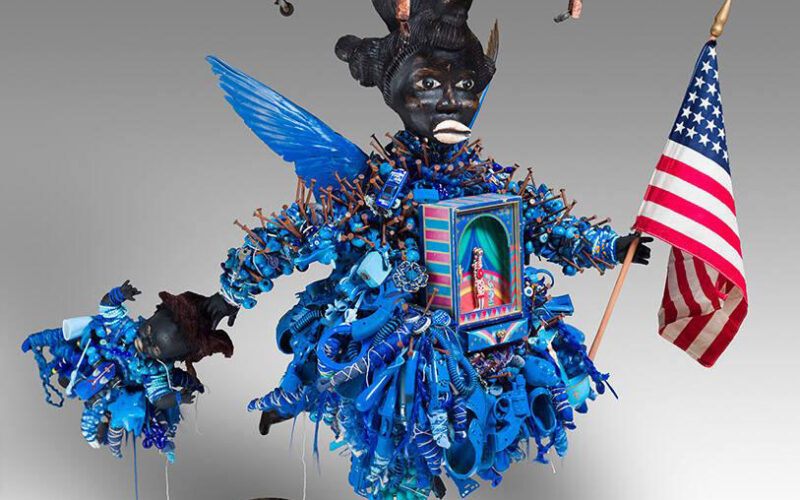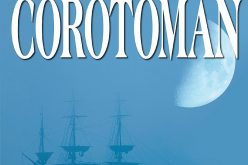April Wallace
awallace@nwaonline.com
When visitors arrive to the latest focus exhibit at Crystal Bridges Museum of American Art, a prompt will greet them: “What does the flag of the United States mean to you?”
Curatorial associate Larissa Randall really hopes the roughly 45 flag-related artworks by 20 different artists will give you food for thought and interesting conversation starters, whether you share your answers to that question with the people you came with, chat about it with staff or new friends at the round table, write it on one of the cards provided or just mull it over mentally.
“Flagged for Discussion” will open April 8 and be on view through Sept. 25, with plenty of special programming on Flag Day, June 14, and the Fourth of July, naturally.
The goal of the focus exhibit is not to provide a history of the American flag, though tidbits of historical context will be provided. Rather it’s a survey of how “artists across time, from the 19th century to today, have turned to the U.S. flag as an aesthetic sort of symbol,” Randall says. “The familiar graphic identity of the U.S. being red and white stripes, with stars symmetrically arranged, is recognizable to people from a lot of different backgrounds.”
“Flagged for Discussion” features artists from many different walks of life and shows how they used the flag as a visual subject for expressing their own pains around belonging, identity, citizenship or nationality, Randall says.
While many of the works are probably things you’re seeing for the first time, the exhibit will feature a couple of all-time crowd favorites too, including Jasper John’s U.S. flag that has 48 stars and Norman Rockwell’s “Rosie the Riveter.”
“Rosie is a work that, whenever we put it on view, people are like ‘Where is she, where is Rosie?’” Randall says. “Even when it’s not on view, we have to answer that. It’s a favorite. But I hope people are really struck by the Vanessa German and the Carla Edwards. Those are a little more unexpected.”
There’s so much in Vanessa German’s “Artist Considers the 21st Century Implications of Psychosis as Public Health Crisis,” otherwise known as “Critical/Comedic Analysis into the Pathophysiology of Psychosis,” that it’s easy to see why it would inspire conversations, even among strangers.
What do you notice first, for instance? That the central figure is riding a skateboard, or that she has wings? That she’s carrying a small child, or that she’s balancing a doll bed full of porcelain figurines on her head? That she’s covered in pins, has a shadow box over her heart, or that she’s holding the American flag in one hand?
“Vanessa German is a living artist we never get tired of celebrating,” Randall says. Her work came into the Crystal Bridges collection for the first time in 2014 as a part of the “State of the Art” exhibition. “She makes these sculpture power figures, what she describes as the ancestral power. … There is a sort of visual presence of these figures that I think will appeal to audiences as powerful — the posture, stance and confidence of them.”
This particular work has been on view at Crystal Bridges before, but never in such a directly patriotic context. Much like Rosie, you might be aware of the flag in the piece, but it may not be the first thing that stands out, Randall says.
Carla Edwards’ “Bonfire” uses the flag not just as inspiration, but as material. To make her piece, Edwards purchased commercially available flags and manipulated them with dye or heat to make new tapestries. This one was made during the 2016 election cycle to express her emotional responses to it.
Two items that will be entirely new to local audiences are on loan from private collections: R.A. Miller’s “Miller Family American Flag” and A.L. Jewell’s “Goddess of Liberty” Weathervane. Jewell was one of the most successful weathervane makers of his time. Throughout the 19th century, Randall says, they became status symbols and got bigger, more ornate and colorful than the ones you might see today. “Goddess of Liberty” was not just his most popular design of the period, but for years she was also his logo and therefore her likeness was on all his ads and other printed materials.
By buying this American symbol, “I would argue they were trying to signal their enthusiasm for the United States or their patriotism,” Randall says. This particular weathervane was mounted on a trophy-like base and brought inside, keeping it in good shape.
The flag by Miller, a self-taught artist who painted the American flag hundreds of times, is an extra special item because it’s used as a family tree. His and his wife’s names, as well as the names and birthdates of their eight children, are on the flag’s stripes.
“This is a very special moment where the flag can suggest family or belonging,” Randall says. “He’s doing it in a very literal way, not painting a family portrait with everyone holding a U.S. flag. (Rather) the flag is a way to express my family.”
FAQ
‘Flagged for Discussion’
WHEN — April 8-Sept. 25
WHERE — Crystal Bridges Museum of American Art 600 Museum Way, Bentonville
COST — Free
INFO — 657-2335 or crystalbridges.org/calendar/flagged-for-discussion/






